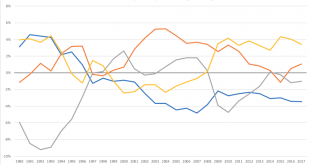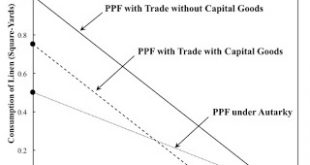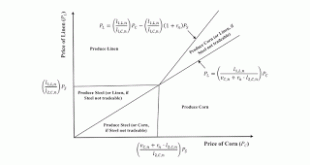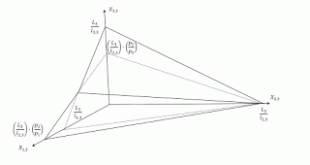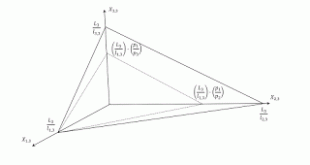Maybe the trade war with China isn't actually about MAGA at all, but just economic warfare against a rising competitor. If trade surplus are so "unfair," why is the focus not on Germany given the figures, enquiring minds want to know. Or, do Donald Trump and his economic team not realize this?Conversable EconomistSome Facts on Global Current Account BalancesTimothy Taylor | Managing editor of the Journal of Economic Perspectives, based at Macalester College in St. Paul, Minnesota
Read More »An Analysis of Financial Flows in the Canadian Economy
An essential but perhaps overlooked way of looking at the economy is a sector financial balance approach. Pioneered by the late UK economist Wynne Godley, this approach starts with National Accounts data (called Financial Flow Accounts) for four broad sectors of the economy: households, corporations, government and non-residents. Here’s how it works: in any given quarter or year each sector can be a net borrower or lender, but the sum of the four sectors’ borrowing/lending must equal to...
Read More »A Country Worse Off With Trade In Capital Goods
Figure 1: PPFs in Portugal1.0 Introduction This post continues these two posts. I change the model here to have wages advanced, not paid out of the surplus at the end of the year. I here consider an example of a model of stationary states in which two countries can trade in produced commodities to be used for consumption. The countries face given prices on international markets for traded commodities. (They are small open economies, in the jargon.) I take the rate of profits as given in...
Read More »More On Foreign Trade In Consumer And Capital Goods
Figure 1: Rates Of Profits for Specialization in Consumer Goods1.0 Introduction This post is a continuation of this example. How a country specializes in foreign trade depends on distribution. And foreign trade can reduce the consumption basket to be divided among the inhabitants of a country, as compared with autarky. 2.0 Patterns of Specialization Assume that the consumption basket in both countries contains both corn and linen. In a steady state, international prices and the...
Read More »Foreign Trade In Capital And Consumer Goods
Figure 1: Specialization In A Single Country1.0 Introduction This post considers how the firms in a small open economy will specialize, given prices on international markets and the domestic rate of profits. The example would only be interesting as part of a larger argument, which I have not yet worked out. 2.0 Technology Consider a small, open economy which has a flow-input, point-output technology for producing two consumption goods, corn and linen. Corn is manufactured from inputs of...
Read More »On the Gain and Loss from Trade
I have written up my recent explorations in the theory of international trade. Abstract: This article considers a model of international trade in which the number of produced commodities does not exceed the number of countries engaged in trade. Technology is modeled such that each commodity can be produced in each country from a finite series of dated labor inputs. The existence of a positive rate of profits may lead a country to specialize differently than how it would with a zero rate...
Read More »Ten things to know about the 2018 Saskatchewan budget
I’ve written a ‘top 10’ blog post about the recently-tabled Saskatchewan budget. Points raised in the blog post include the following: -This year’s budget was quite status quo. -Last year’s budget, by contrast, included a series of cuts to social spending. Last year’s budget also announced cuts to both personal and corporate income taxes that were subsequently reversed. -Saskatchewan has one of the lowest debt-to-GDP ratios in Canada. -This recent budget announced the phase out of a rent...
Read More »Class Struggle And Specialization In International Trade
This post continues a previous numeric example. The firms in each of three countries are assumed to know a technology for producing corn, wine, and linen. The technology is such that each commodity can be produced in each country. The technology varies among countries. Each of these small open economies can specialize and obtain non-produced commodities through foreign trade. I confine myself to patterns of specialization in which: Each country produces exactly one commodity...
Read More »The Gain And Loss From Trade: More On A Numeric Example
Figure 1: The Production Possibility Frontier, With And Without Trade, In "Germany"1.0 Introduction I continue to blunder around in parameter space in exploring my numeric example in the previous post. In this post, I continue to adopt the same assumptions for a model of three countries engaged in international trade with three produced commodities. In particular, workers are assumed to be unable to immigrate, capitalists only invest in their own country, and produced means of production...
Read More »The Loss From Trade: A Numeric Example With Three Countries And Three Produced Commodities
Figure 1: The Production Possibility Frontier, With And Without Trade, In "Germany"1.0 Introduction This post presents a numeric example of a Ricardian model of small, open economies engaged in trade. Each of three countries specializes in producing one of three commodities. Technology is modeled following an Austrian approach. Each commodity can be produced in each country from inputs of labor and "capital". Endowments of labor are taken as given parameters. It makes no sense to take the...
Read More » Heterodox
Heterodox

